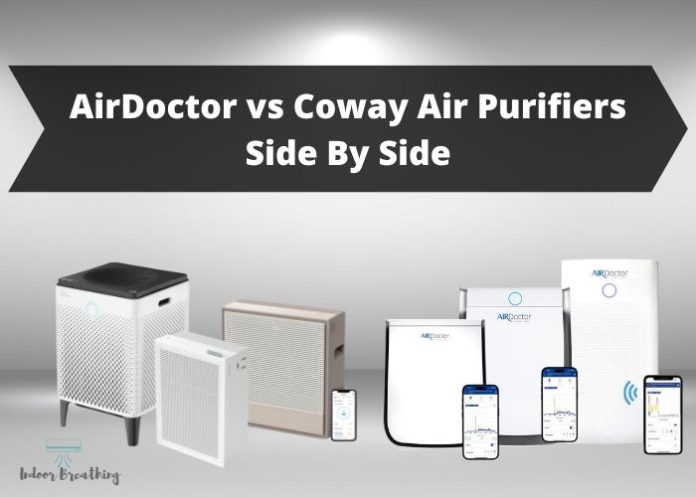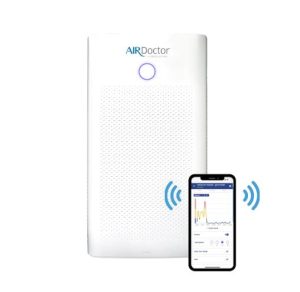Both AirDoctor and Coway are reputable air purifier brands. AirDoctor currently has 7 models, while Coway has 15.
We won’t compare them all but only the most popular ones. And so, to be fair, we will compare similar cleaners to similar ones based on coverage.
As both have wi-fi enabled and non-wi-fi models, we decided to compare only wi-fi enabled models with mobile apps if available.
Let’s begin with the small capacity models – Air Doctor 2000i and Coway Airmega 150.
Table of Contents
Air Doctor 2000i and Coway Airmega 150
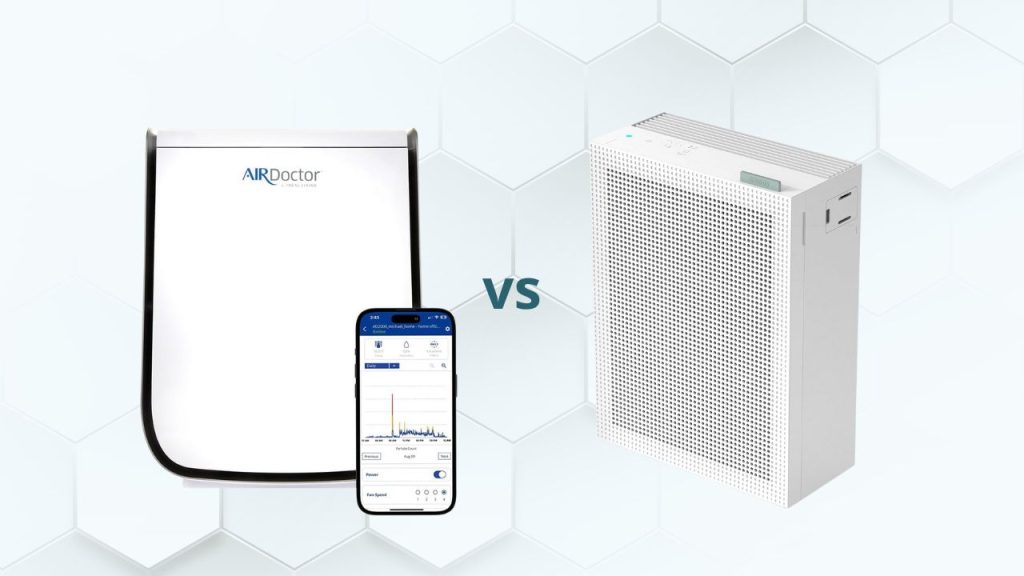
AirDoctor comes in 2 variants – 2000 without wi-fi and 2000i with wi-fi. And so, as all other features are the same, let’s look at the 2000i model.
Air Doctor 2000i comes in one color option, while Coway Airmega 150 has 3 to choose from – white, green, and pink.
Both air purifiers are very similar in size as well. Air Doctor 2000i is 14” (W) x 6.6” (D) x 18.7” (H), while Coway Airmega 150 is 13.4” (W) x 6.5” (D) x 18.5” (H). 2000i model weighs 10lbs and Airmega 150 12lbs.
Both models have an air inlet from one side – the front and an air outlet through the top. Controls are also placed on the top. But here is the difference.
AirDoctor’s controls look great, and the overall design looks more modern, while Coway looks more old-fashioned, and controls are very general.
Features

With the Airdoctor 2000i control panel, you have the option to turn on and off the air purifier, switch between 4 fan speeds, choose an auto mode or dim mode, set a timer, lock controls, see filter change indicators, reset filters and turn on and off ion generator.
With Coway Airmega 150 controls, you can turn the air purifier on and off, switch between 3 fan speeds or auto mode, see filter indicators, and reset filters.
Both air purifiers have air quality sensors, showing real-time air quality with a light indicator next to the power button. Airdoctor has a large circle, while Coway has a small dot-style light.
Air Doctor 2000i is also equipped with Wi-Fi and a mobile app, which allows you to do all the same things as the air purifier control panel. Plus, you have an air quality monitor, and you can follow real-time or check historical air quality data, see temperature and humidity, and see filter life in percentage.
Alternatively, you can save money and get AirDoctor 2000 without Wi-Fi.
Performance
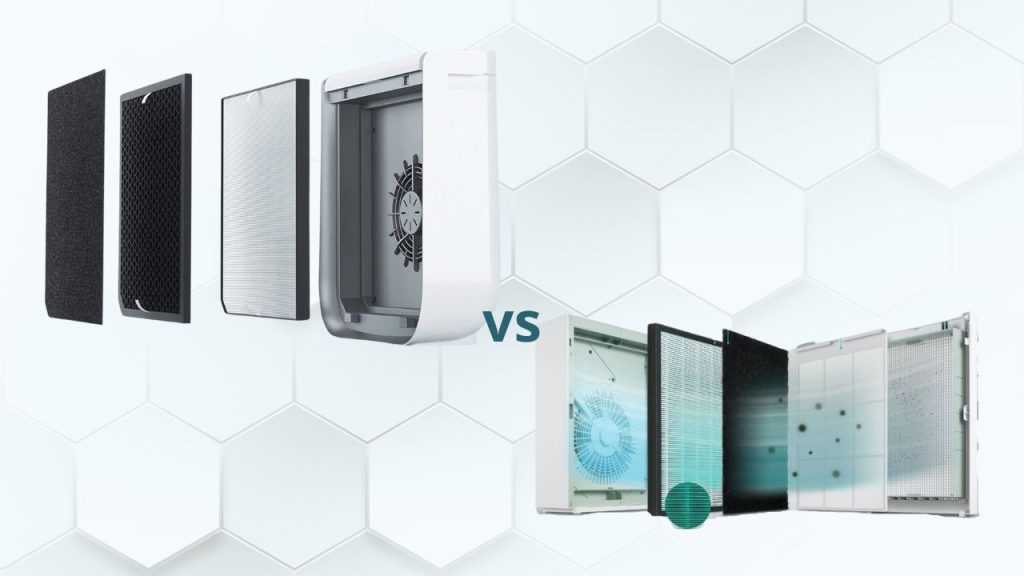
Both air purifiers have washable pre-filters that capture the largest particles, such as hair, pet dander, and dust.
Then, both have carbon filters that capture odors and harmful VOCs. Carbon filters work great for moderate food smell, pet smell, and other odors, but remember that they are not too thick, so they won’t filter heavy odors.
For Coway, the last one is the True-HEPA filter, with the capability to trap 99.97% of particles as small as 0.3 microns, while Airdoctor 2000i has a patented UltraHEPA filter with the ability to trap 99.97% of particles down to 0.003 microns.
So, AirDoctor can trap 100 times smaller particles, including bacteria and viruses.
AirDoctor 2000i is the smallest one from AirDoctor and can cover 244 sq. ft. rooms in 12 minutes or 610 sq. ft. in 30 minutes. CADR is 152 cfm.
Coway Airmega 150 is the smallest from the Coway family and can clean 205 sq. ft. in 12 minutes and 518 sq. ft. in 30 minutes. CADR is 153 cfm.
So, the coverage and CADR ratings are very similar.
Noise Level And Energy Consumption
The Coway Airmega 150 wins because it consumes only 35 watts, and the noise level is between 20 and 48 dB.
Air Doctor 2000i consumes between 11 and 110 watts, and the noise level is between 38 and 59 dB.
As both units have auto mode, they will switch to lower fan speed as soon as air quality increases, so energy consumption will be lower as well, and there will be less noise.
Maintenance Costs

Air purifiers aren’t devices you set and forget. You need to maintain them because filters get dirty over time. As both devices have washable pre-filters, the other filters’ lifetime increases.
AirDoctor’s recommendation is to change the carbon filter once every 6 months and the UltraHEPA filter once a year.
The same recommendations come from Coway – 6 months for the carbon filter and 12 for the TrueHEPA filter.
Changing filters is straightforward for both machines, so let’s look at filter prices.
Air Doctor 2000i offers a combo pack with 2 carbon filters and 1 HEPA filter, which costs $135 (or $103 if you purchase with our 10% discount link here).
Or you can purchase filters separately for $45 each.
Coway Airmega 150 offers a combo pack, including 2 carbon filters and 1 HEPA filter, for $50. Unfortunately, you can’t buy HEPA or Carbon filters separately.
Which Is Better?
If we consider performance, design, and smart features, then Air Doctor 2000i is the winner. It captures a bit larger space, 100x smaller contaminants, and has wi-fi and app control.
Coway Airmega 150, on the other hand, offers good purification, energy efficiency, quietness, and cheaper replacement filters.
So you have to decide which aspects suit you and pick accordingly.
But if you need larger coverage air purifiers, keep reading because now we will review AirDoctor 3500i and Coway Airmega 250S.
Air Doctor 3500i and Coway Airmega 250S
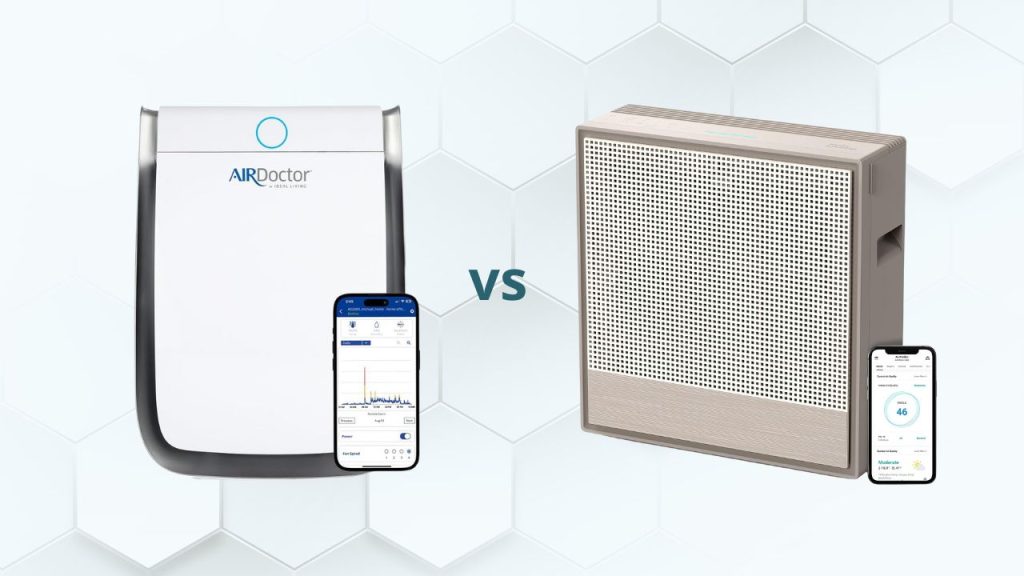
AirDoctor comes in 2 variants – 3500 without wi-fi and 3500i with wi-fi. Coway also has model 250 without wi-fi and 250s with it. So we compared both wi-fi enabled version models.
Air Doctor 3500i and Coway Airmega 250S come in one color option – no option for design changes. Airdoctor is white, but Coway is gray.
AirDoctor 3500i is 15.7” (W) x 8.3” (D) x 23” (H), while Coway Airmega 250S is 18.5” (W) x 8.3” (D) x 19.7” (H). So AirDoctor is a bit taller, but the Coway model is wider.
3500i model weighs 18 lbs and Airmega 250S 20.5 lbs.
Both models have an air inlet from one side – the front and an air outlet through the top. Controls are also placed on the top.
Features
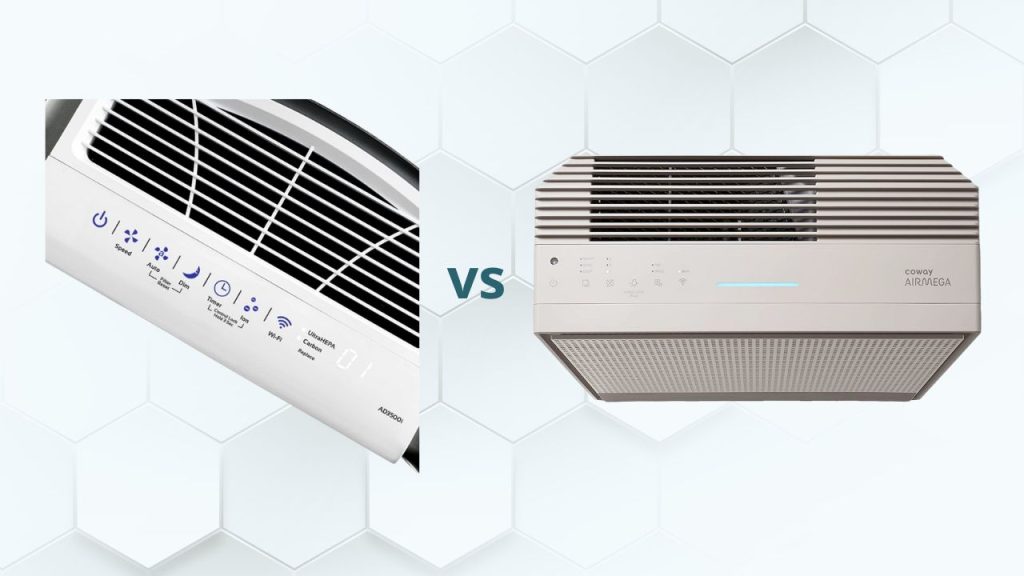
With the Airdoctor 3500i control panel, you have the option to turn on and off the air purifier, switch between 4 fan speeds, choose an auto mode or dim mode, set a timer, lock controls, see filter change indicators, reset filters and turn on and off ion generator. And, of course, activate the Wi-Fi function.
With Coway Airmega 250S controls, you can turn the air purifier on and off, switch between 3 fan speeds, auto, rapid, and sleep modes, see filter indicators, reset filters, and activate the Wi-Fi function.
Both air purifiers have air quality sensors, showing real-time air quality with a light indicator. Airdoctor has a large circle on the top side of the front, while Coway has a small line-style light on the top.
Both air purifiers have Wi-Fi and a mobile app, which allows you to do all the same things as the air purifier control panel.
Both air purifier apps have an air quality monitor, and you can follow real-time or check historical air quality data, see temperature and humidity, and see filter life in percentage.
Coway also has voice control, but the Air Doctor app can customize it and pass control over the air purifier to a friend.
Alternatively, you can save money and get Coway Airmega 250 or AirDoctor 3500 without Wi-Fi.
Performance
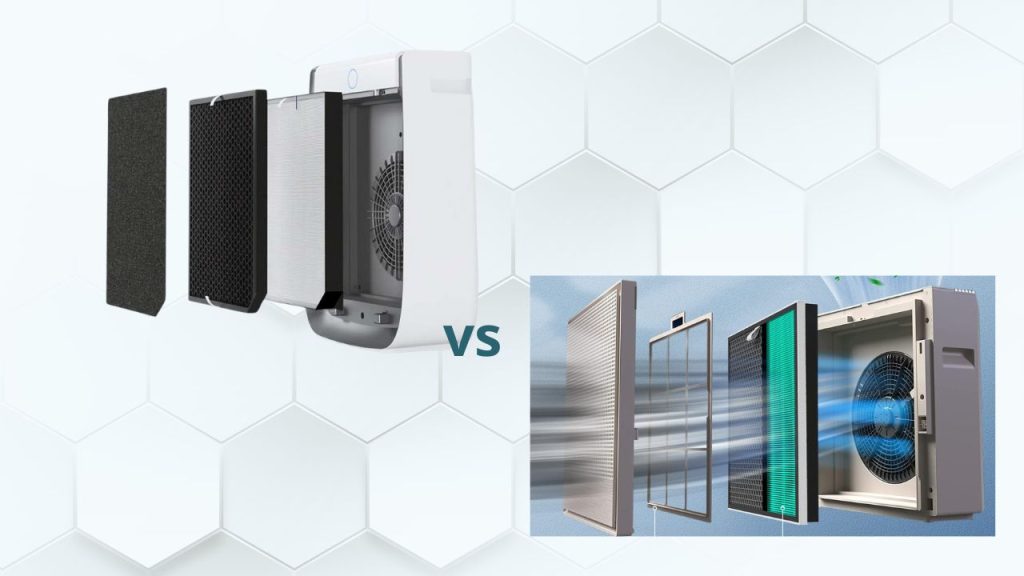
Both air purifiers have washable pre-filters that capture the largest particles, such as pet dander, hair, and dust.
Then, both have carbon filters that capture odors and harmful VOCs. Carbon filters work great for moderate food, pets, and other odors. They filter smoke as well.
The last one for Coway Airmega 250S is the Green True-HEPA filter, with the capability to trap 99.97% of particles as small as 0.01 microns, while Airdoctor 3500i has a patented UltraHEPA filter with the ability to trap 99.97% of particles down to 0.003 microns.
Airdoctors can trap smaller particles but are also great for filtering bacteria and viruses.
Another difference is that Airdoctor has separate carbon and HEPA filters, while Coway combines them as one filter called Max2.
AirDoctor 3500i is the middle model between the small and large one from AirDoctor and can cover 505 sq. ft. rooms in 12 minutes or 1,262 sq. ft. in 30 minutes. CADR is magnificetn 326 cfm.
Coway Airmega 250S is an air purifier for medium spaces from the Coway family and can clean 372 sq. ft. in 12 minutes and 930 sq. ft. in 30 minutes. CADR is 249 cfm.
So, overall, Airdoctor is more powerful and has better air purification.
Noise Level And Energy Consumption
The Coway Airmega 250S consumes only 64 watts on max, and the noise level is between 22 and 54 dB.
Air Doctor 3500i consumes between 11 and 110 watts, and the noise level is between 39 and 59 dB.
As both units have auto mode, they will switch to lower fan speed as soon as air quality increases, so energy consumption will be lower as well, and there will be less noise.
Both devices are energy efficient and, on auto mode, mostly work quietly.
Maintenance Costs
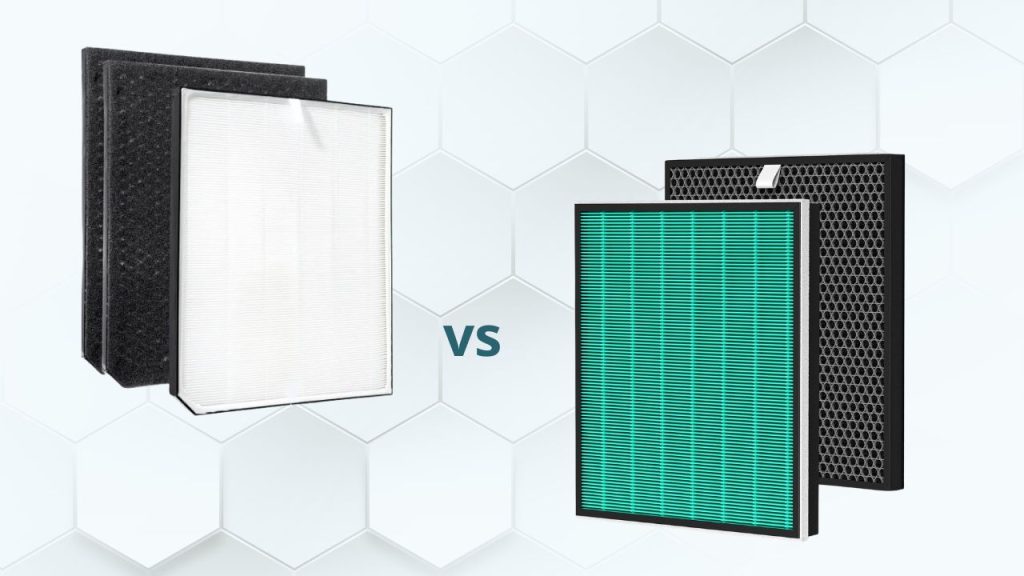
Both models have washable and easy-to-dry pre-filters. Other filters are replaceable.
AirDoctor recommends changing the carbon filter once every 6 months and the UltraHEPA filter once a year.
Coway says the Max2 lifetime is 12 months. In reality, carbon filters need to be changed more frequently, but as you can’t buy them separately, you must buy a combined Max2 filter, including both carbon and HEPA filters, at least twice a year.
Changing filters is easy for air purifiers, so let’s look at filter prices.
AirDoctor 3500i offers a combo pack with 2 carbon filters and 1 HEPA filter, which costs $179 (or $137 if you purchase with our 10% discount link here).
Or you can purchase filters separately for $53 each.
Coway Airmega 250S offers Airmega 250 Max2 Filter for $79, but as mentioned before, you will need to buy it 2x per year, costing you $158.
Which Is Better?
Not only did we decide that Air Doctor 3500i is better, but also reviews from other resources say the same.
AirDoctor wins with better quality purification, modern design, and higher capacity coverage. Its app is also more intuitive and works better.
Coway Airmega 250S also offers great performance but is not as powerful, with a much lower CADR rating, fan speeds, and an air quality sensor that is not as good. But it consumes less energy and costs a bit less than AirDoctor 3500i.
Now, look at Coway’s and AirDoctor’s largest and most powerful air purifiers – Airmega 400S and AD5500i.
Air Doctor 5500i and Coway Airmega 400S
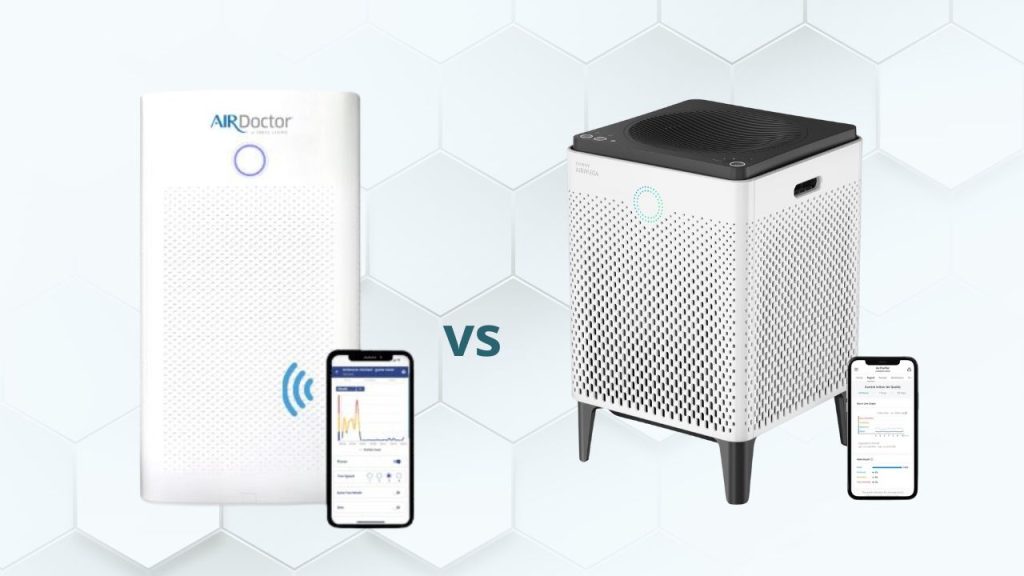
Air Doctor 5500i comes in one color option, while Coway Airmega 400S has 2 to choose from – white and graphite gray.
AirDoctor 5500i is 16” (W) x 16” (D) x 29.7” (H), while Coway Airmega 400S is 14.8” (W) x 14.8” (D) x 22.8” (H). 5500i model weighs 33lbs and Airmega 400S 24.7lbs.
Both models are large and require space. Both models have handles to lift them, and Airdoctor 5500i even has wheels for easier portability.
Both models have dual suction purification. That means the fan is in the middle, and filters come from both sides, so the air is being filtered from 2 sides simultaneously.
Controls are at the top of air purifiers. While AirDoctor 5500i controls look great and most functions are there, Coway Airmega 400S lacks most controls and only a few small but necessary buttons.
This means they want you to use the app, but more about it in the next section.
Features
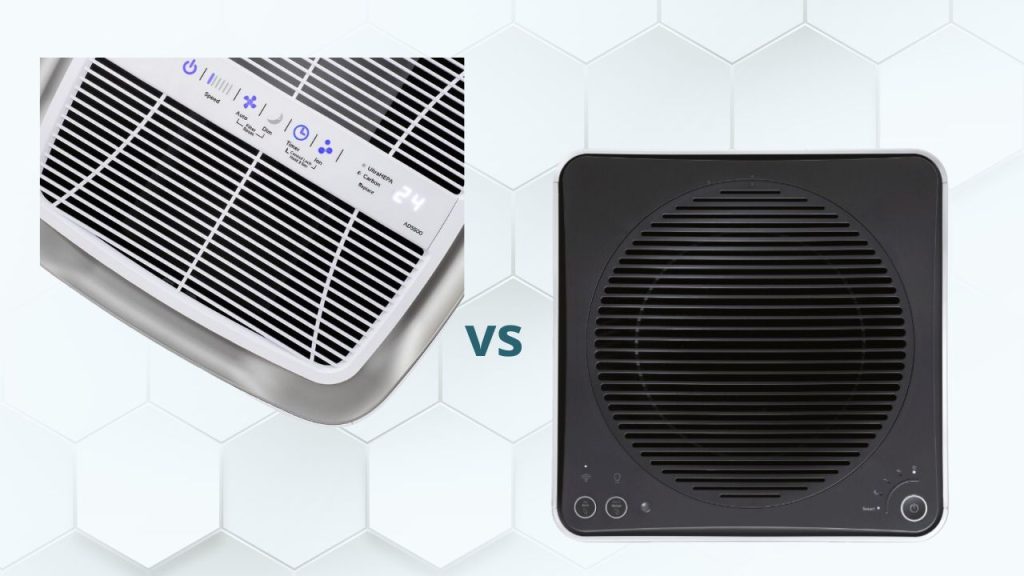
With the Airdoctor 5500i control panel, you have the option to turn on and off the air purifier, switch between 6 fan speeds, choose an auto mode or dim mode, set a timer, lock controls, see filter change indicators, reset filters and turn on and off ion generator. And, of course, activate the Wi-Fi function.
With Coway Airmega 400S controls, you can turn the air purifier on and off, switch between 4 fan speeds, see filter indicators, reset filters, activate the Wi-Fi function, and turn on/off light and air quality indicators.
Both air purifiers have air quality sensors, showing real-time air quality with a light indicator. Both air purifiers have a large circle on the top side of the front.
Both air purifiers have Wi-Fi and a mobile app. Both air purifier apps have an air quality monitor, and you can follow real-time or check historical air quality data, see temperature and humidity, and see filter life in percentage.
Coway also has voice control, but the AirDoctor app can customize it and pass control over the air purifier to a friend.
While the AirDoctor app feels intuitive and looks clean, the Coway app feels outdated and needs updating.
Performance
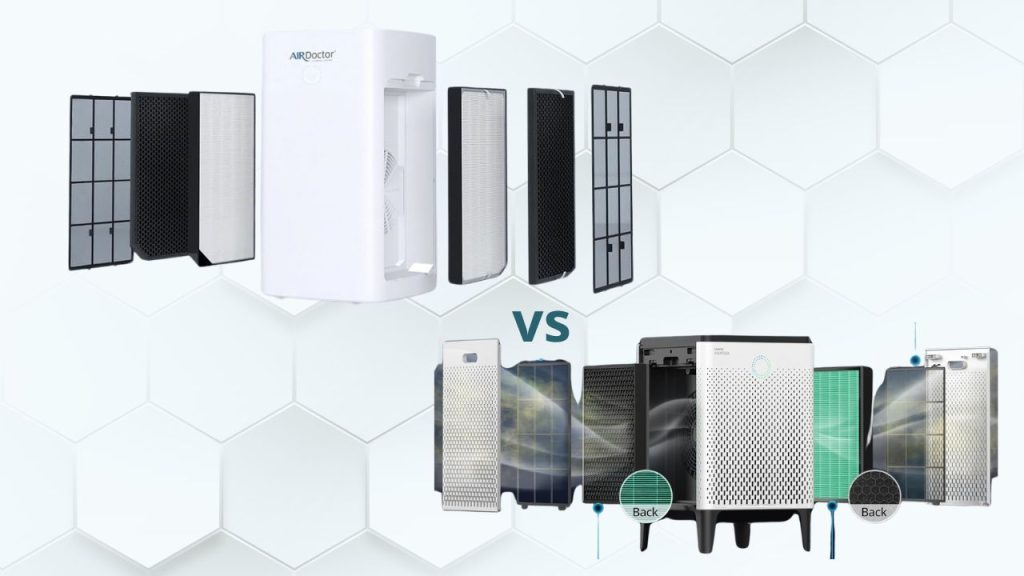
Both air purifiers have washable pre-filters that capture the largest particles, such as pet dander, hair, and dust.
Then, both have large and thick carbon filters that capture odors and harmful VOCs. Carbon filters work great for food, pets, and other odors. They reduce toxic ozone, gas, and other odors from cooking, cleaners, hairspray, and more.
The last one for Coway Airmega 400S is the Green True-HEPA filter, with the capability to trap 99.99% of particles as small as 0.01 microns, while Airdoctor 5500i has a patented UltraHEPA filter with the ability to trap 99.99% of particles down to 0.003 microns.
These filters can filter viruses, mold, bacteria, dust particles, and more.
Air Doctor 5500i can cover massive 868 sq. ft. rooms in 12 minutes or 2,170 sq. ft. in 30 minutes. CADR is magnificetn 560 cfm.
Only industrial air purifiers have better numbers, so this is the best.
Coway Airmega 400S can clean 624 sq. ft. in 12 minutes and 1,560 sq. ft. in 30 minutes. CADR is 328 cfm.
So, overall, the Airdoctor can purify smaller particles and is more powerful.
Noise Level And Energy Consumption
The Coway Airmega 400S consumes only 66 watts on max, and the noise level is between 22 and 52 dB.
Air Doctor 5500i consumes between 10 and 100 watts, and the noise level is between 30 and 50 dB.
Those numbers are insanely good compared to the air purifiers’ size and filter capability.
As both air purifiers have auto mode, they will work at a lower fan speed as soon as air quality increases, so energy consumption will be lower as well, and there will be less noise.
Both devices are energy efficient and, on auto mode, mostly work quietly despite their large size.
Maintenance Costs
Both models have washable and easy-to-dry pre-filters. Other filters are replaceable.
AirDoctor recommends changing the carbon filter once every 6 months and the UltraHEPA filter once a year.
Coway says the Max2 lifetime is 12 months. In reality, carbon filters need to be changed more frequently, but as you can’t buy them separately, you must buy a combined Max2 filter, including both carbon and HEPA filters, at least twice a year.
Changing filters is easy for air purifiers, so let’s look at filter prices.
AirDoctor 5500i offers a combo pack with 4 carbon filters and 2 UltraHEPA filters, which costs $375 (or $287 if you purchase with our 10% discount link here).
Or you can purchase filters separately for $112 each.
Coway Airmega 400S offers Airmega 400 Max2 Filter for $129 or a combo pack with 2 filters for $232, but as mentioned before, you will need to buy it 2x per year, costing you $464.
So basically, if you want to have your odors purified, you have to spend way more than for AirDoctor’s replacement filters.
Which Is Better?
Air Doctor 5500i is a clear winner thanks to the ability to filter smaller particles and larger spaces. It has casters for easy portability. It has better touch controls. It is a more intuitive and easier-to-use mobile app.
Coway Airmega 400S costs less, consumes less energy, and has 2 color options. Someone will find the design more attractive; it is also less heavy and shorter than the Airdoctor 5500i.
We hope we have made your decision easier now. So many air purifiers are out there, and we understand it may be difficult to choose. But it depends on your needs as well.
And when you know what you want, it is the easier choice.
Take a look at a few of our other air purifier comparison reviews below:

